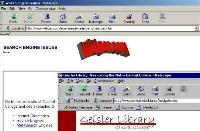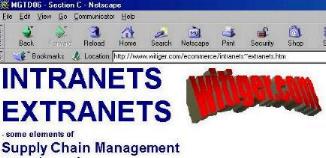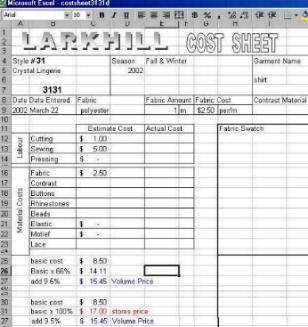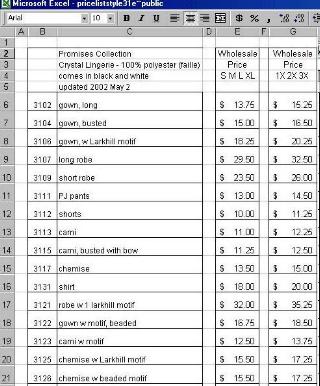
CCT 322

CCT 322 |
Marketing Information Products & Services |
| Section A | Section B | Section C | Section D | Section E |
| .. |
Sometimes the best way to sell a product or service from one business to another business is to provide convincing evidence as to how attractive the product will be to the final customer. WTGR |
|
Chapter 12 
Personal Selling |
Personal Selling
selling powerpoint
7
steps in selling process
|
.
 |
A special unit all about
Search Engines
see www.witiger.com/ecommerce/searchengineranking.htm Things to Increase Your Ranking in Search Engines This will be discussed at
length in class.
|
Chapter 13
 |
Retailing - Direct Marketing ----- Direct Mail ----- Cataloque Retailing ----- Television Shopping ----- Internet Shopping (Online Marketing / AKA e-commerce / e-business) The CCT 322 text discusses
Internet Shopping on page 399
|
Chapter 14
 |
Wholesaling - a consequence of many small and medium sized manufacturers not having the resources to have their own sales and marketing people Types of Wholesalers
Multiple Distribution
Channels
|
Chapter 14

Exporting |
Distribution to Foreign Markets - see www.witiger.com/universityoftoronto/MGTC44.htm Ways to enter foreign markets
|
.
Chapter 14
 |
Supply Systems and Supply Chain Management
|
 |
What
is the Supply Chain?
www.supply-chain.org/Resources/faq.htm "The supply chain -- a term now commonly used internationally -- encompasses every effort involved in producing and delivering a final product or service, from the supplier's supplier to the customer's customer. Supply Chain Management includes managing supply and demand, sourcing raw materials and parts, manufacturing and assembly, warehousing and inventory tracking, order entry and order management, distribution across all channels, and delivery to the customer." Why
is the supply chain important?
|

| Supply
Chain Management an
Supply
an
|
Supply-Chain Management
as explained in the FAQ of the
Center for Electronic Commerce 
http://cism.bus.utexas.edu/resources/ecfaq/ecfaqc2.html Q.
What is supply chain management?
key points, as translated by witiger
What might be missing from the definition above
|

this definition is OK, on a general level, but it is not complete enough for a full understanding (our MGTC44 expanded version) "a company's supply chain encompasses the
|
| JIT
Just In Time |
Industry activities to deal with enhancing effectiveness of Supply Chain Management
information competitiveness What has changed in the millennium is the need to quickly share and disseminate information across the supply chain, - this follows a shift from product orientation, to sales orientation to market orientation. Pull versus Push Supply Chain
models
- Pull based models
require a lot of information about the customer
|
| Supply
Chain Component Parts Supply
Supply
|
Supply Chain
Management
as explained in the Schneider and Perry book, Chapter 9 - the component parts
|
 |
A special unit all about
Intranets and Extranets
This is required reading for CCT 322 This "extends" information found about Supply Chain management in Chpt 14 of the CCT 322 text |
| .. |
The technologies of the Internet have created situations about pricing Information Products & Services which have not been "captured" in traditional marketing textbooks - we will look at some of these. WTGR |
|
Chapter 15 
Quality |
Price proportionate
to Quality
Consumer perceptions of the Quality and the price they are willing to pay The text says "some consumer's perceptions of product and service quality vary directly with price. Typically the higher the price the better the quality is perceived to be". However striving for high
quality is not so simple, there are things you might have to give up. as
Dilbert suggests
see TQM page at www.witiger.com/internationalbusiness/TQM.htm |
"More managers
are realizing that they should set prices by evaluating the effect of a
price decision not only on the profit margin for a given item but also
on demand..." p. 482 Shapiro
|
|
Chapter 15 
Price and Productivity |
 |
Chapter 15

Trade Discounts page 475 |
Pricing Terms
used in B2B
2/10 - net 30 in a business to business (B2B) situation it is common to have to extend credit to customers who are buying parts, materials and supplies. 2 is the % discount 10 is the number of days 30 is the maximum number of days in which you HAVE to pay 2/10 net 30 means if you may before 10 days, you get a 2% discount 5/10 net 60
|
| Price Setting in the Real World - Most price structures are built around list prices | |
 |
In the "Real World", most
manufacturers create a cost sheet for each product, then combining the
cost sheets leads to a price list for a group of products.
If you click on the screen capture to the left you will see a real cost sheet used by a clothing manufacturing company - it is done in Excel so when various factors change, you can have the final cost calculation easily. |
 |
If you click on the screen capture to the left you will see a real price list which has been composed from cost sheets. This Price List is the basics from which all price objectives come from - its is from the numbers on this list that you increase by 10%, 20% or 50% your price |
| Markups
Markup percent is based on selling price In the clothing industry it is usually 100% - this means if your calculated mfg. cost price of a garment is $20 - it will wholesale at $40, the retailer will mark it up to $80, or even $90 depending on the category. "Mark-up Chain"
"High markups don't always
mean big profits"
It is also important to note that the level of the mark-up depends on whether the product is a consumer product/service or an industrial product/service - BECAUSE,,,, consumer products/services often have more money spent on promotional expenses - therefore the need to recover this in a higher mark-up. level of the mark-up depends on whether the product is:
|
| Stockturn rate (p.
485 Shapiro)
If you spend a lot of money to acquire inventory - it will cost you
One of the best things you can do is "turn over" your stock quickly. Once or twice a year is bad, four or five times a year is good. Cash flow is sometimes more important that an absolute profit. When you turn over the stock, you get cash flow. |
| Chpt 15
Total Costs |
There are three
kinds of total costs
- rent, utilities, agent commission, insurance - things that do not change no matter how much you produce - material, supplies, component parts, wages and salaries, shipping - things that increase, when you increase production - the sum of Total Cost + Variable Cost There are Three Kinds of Average Cost
|
|
|
CONTACTIMAIN PAGE I NEWS GALLERY IE-BIZ SHORTCUTS I INT'L BIZ SHORTCUTS IMKTG&BUSINESS I TEACHING SCHEDULE IMISTAKES ITEXTS USED IIMAGESIRANKI |
| . |